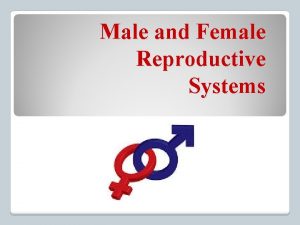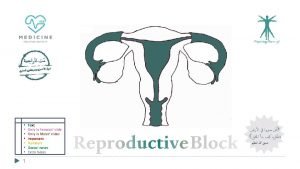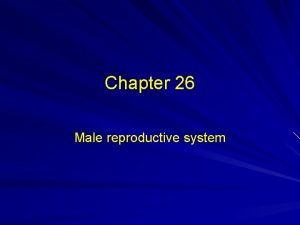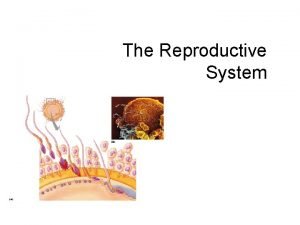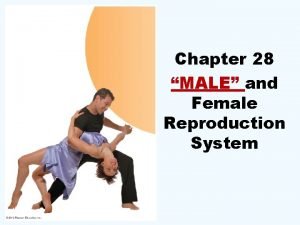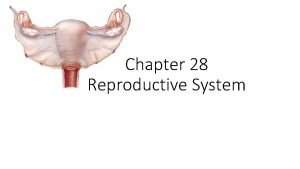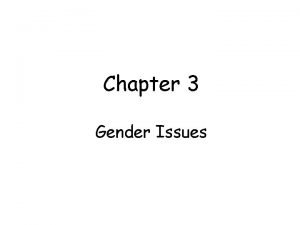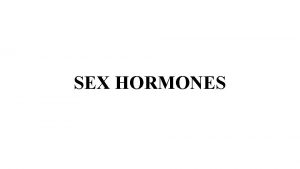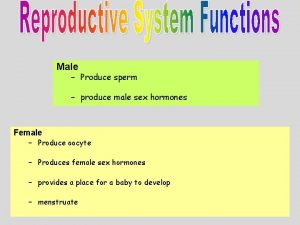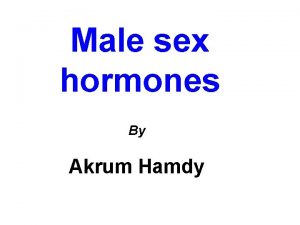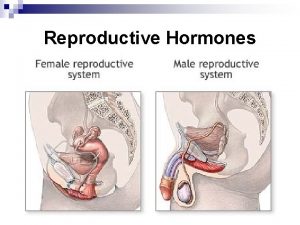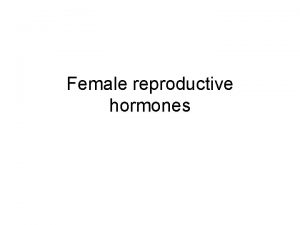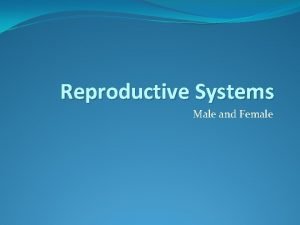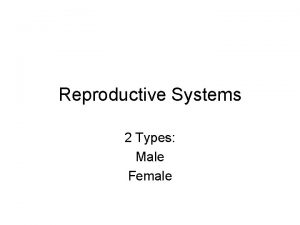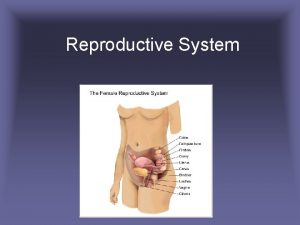Reproductive System Male Reproductive System Female Sex Hormones



















- Slides: 19

Reproductive System

Male Reproductive System




Female Sex Hormones Pituitary Gland ◦ FSH - Stimulates the development of follicles Follicle - Fluid filled sacs that contain an egg cell ◦ LH – Stimulates follicles to become mature, release their egg (ovulation) and then develop into a structure called the corpus luteum Ovary ◦ Estrogen and Progesterone Stimulate the development of secondary sexual characteristics during puberty Stimulate the development of the uterus lining during pregnancy Rise and fall in a cycle (unless woman is pregnant)

Male Sex Hormones Testes – produce Testosterone Role of Testosterone ◦ One of the hormones needed to make sperm in testes ◦ Secreted by developing testes to form male genitalia in a fetus ◦ Levels rise and fall during puberty Causes secondary sexual characteristics to form ◦ During adulthood, maintains male sex drive Evolutionary drive to reproduce, maintains desire to pass on genes to offspring

Primary Sex Characteristics vs Secondary Primary Sex Characteristics ◦ Testes, penis (men) ◦ Ovaries, etc (women) Secondary Sex Characteristics ◦ ◦ ◦ Pubic hair Enlarged breasts (women) Enlarged penis (men) Growth of skeletal muscles (men) Fat storage (women)

The Menstrual Cycle Menarche – a woman’s first menstrual period Cycle controlled by levels of FSH and LH produced by pituitary gland Estrogen and Progesterone produced by the ovary

Menstrual Cycle FSH level rises at the beginning to stimulate follicle development and estrogen secretion LH peaks and causes the egg to be released from the follicle – ovulation LH causes the follicle to release less estrogen and more progesterone. After ovulation, LH causes the follicle to develop into the corpus luteum High progesterone levels and estrogen levels inhibit FSH and LH secretion. (Negative feedback) FSH levels rise again and the next menstrual cycle begins



Videos http: //www. youtube. com/watch? v=WGJsr. Gm We. KE

Infertility Not being able to become pregnant after 1 year of trying Approximately 10% of all women between the ages of 15 – 44 have problems either becoming pregnant or staying pregnant (according to the CDC) 1/3 of all cases are due to male infertility 1/3 of all cases are due to female infertility 1/3 of all cases are due to unknown issues

Infertility Causes Low sperm count or sperm motility Environmental or general health issues Fallopian tube damage Ovulation disorders Pelvic scarring Blockage of the cervix (stenosis)

In Vitro Fertilization (IVF) Manually fertilizing an egg outside of the womb by combining it with sperm Typically performed in a laboratory dish An embryo transfer then takes place where the fertilized egg (now an embryo) is then implanted into the mother’s womb


http: //www. youtube. com/watch? v=Geig. Yib 39 Rs

Ethical Issues of IVF Pros ◦ Previously infertile couples are able to have children ◦ Allows families for people who are sterilized for various reasons Chemotherapy Cancer treatments Cons ◦ What happens to unwanted embryos? ◦ Possible health risks for women
 Male and female hormones
Male and female hormones Male and female hormones
Male and female hormones Primary sex organ of the male reproductive system? *
Primary sex organ of the male reproductive system? * Male and female reproductive system
Male and female reproductive system Parts of male and female reproductive system
Parts of male and female reproductive system Differences between male and female reproductive organ
Differences between male and female reproductive organ Drawing of the male and female reproductive system
Drawing of the male and female reproductive system Uncut penis
Uncut penis Bony vs cartilaginous fish
Bony vs cartilaginous fish Sex sex sex
Sex sex sex Snv sex
Snv sex Xxtesticles
Xxtesticles Sex sex sex
Sex sex sex Sex sex sex
Sex sex sex Sex male and female
Sex male and female Uocyhtuzwza -site:youtube.com
Uocyhtuzwza -site:youtube.com Hormones after sex
Hormones after sex Function of vagina
Function of vagina Reproductive hygiene
Reproductive hygiene Exercise 42 review male reproductive system
Exercise 42 review male reproductive system
